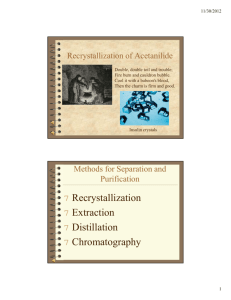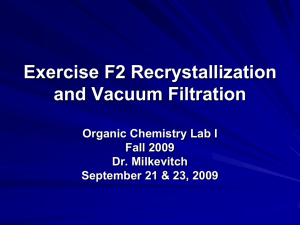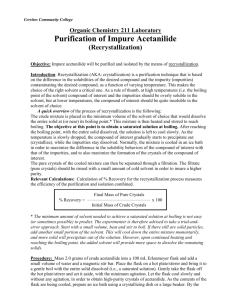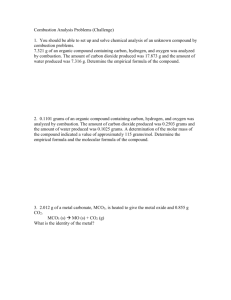Recrystallization
advertisement
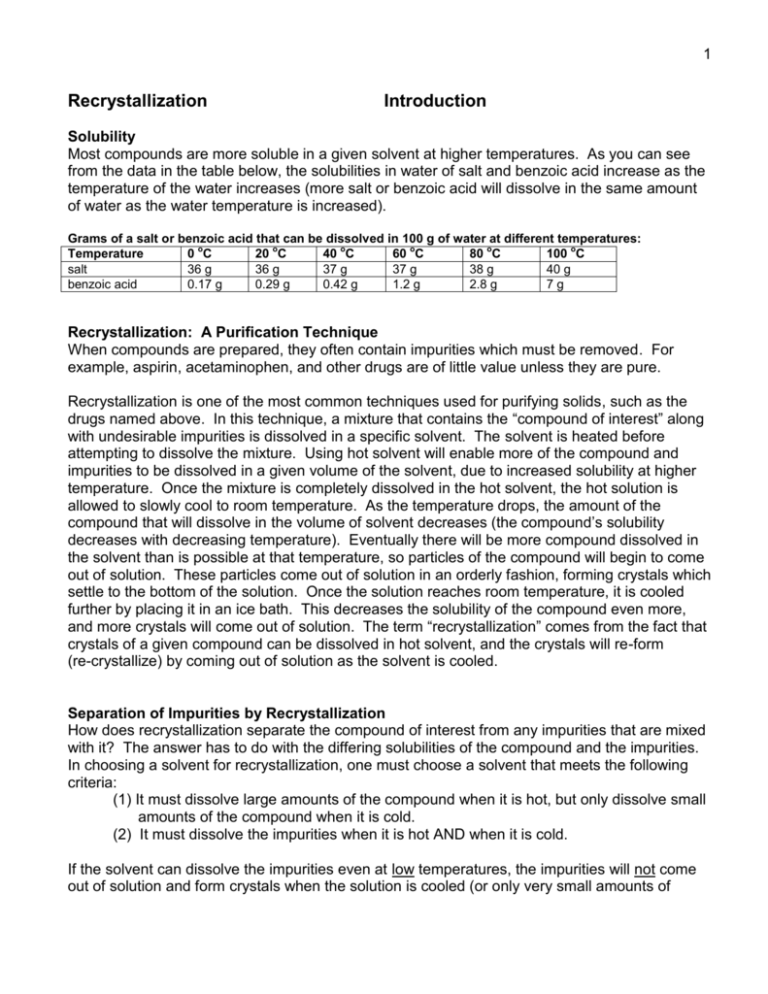
1 Recrystallization Introduction Solubility Most compounds are more soluble in a given solvent at higher temperatures. As you can see from the data in the table below, the solubilities in water of salt and benzoic acid increase as the temperature of the water increases (more salt or benzoic acid will dissolve in the same amount of water as the water temperature is increased). Grams of a salt or benzoic acid that can be dissolved in 100 g of water at different temperatures: o o o o o o Temperature 0 C 20 C 40 C 60 C 80 C 100 C salt 36 g 36 g 37 g 37 g 38 g 40 g benzoic acid 0.17 g 0.29 g 0.42 g 1.2 g 2.8 g 7g Recrystallization: A Purification Technique When compounds are prepared, they often contain impurities which must be removed. For example, aspirin, acetaminophen, and other drugs are of little value unless they are pure. Recrystallization is one of the most common techniques used for purifying solids, such as the drugs named above. In this technique, a mixture that contains the “compound of interest” along with undesirable impurities is dissolved in a specific solvent. The solvent is heated before attempting to dissolve the mixture. Using hot solvent will enable more of the compound and impurities to be dissolved in a given volume of the solvent, due to increased solubility at higher temperature. Once the mixture is completely dissolved in the hot solvent, the hot solution is allowed to slowly cool to room temperature. As the temperature drops, the amount of the compound that will dissolve in the volume of solvent decreases (the compound‟s solubility decreases with decreasing temperature). Eventually there will be more compound dissolved in the solvent than is possible at that temperature, so particles of the compound will begin to come out of solution. These particles come out of solution in an orderly fashion, forming crystals which settle to the bottom of the solution. Once the solution reaches room temperature, it is cooled further by placing it in an ice bath. This decreases the solubility of the compound even more, and more crystals will come out of solution. The term “recrystallization” comes from the fact that crystals of a given compound can be dissolved in hot solvent, and the crystals will re-form (re-crystallize) by coming out of solution as the solvent is cooled. Separation of Impurities by Recrystallization How does recrystallization separate the compound of interest from any impurities that are mixed with it? The answer has to do with the differing solubilities of the compound and the impurities. In choosing a solvent for recrystallization, one must choose a solvent that meets the following criteria: (1) It must dissolve large amounts of the compound when it is hot, but only dissolve small amounts of the compound when it is cold. (2) It must dissolve the impurities when it is hot AND when it is cold. If the solvent can dissolve the impurities even at low temperatures, the impurities will not come out of solution and form crystals when the solution is cooled (or only very small amounts of 2 impurities will come out of solution). Therefore, the crystals that form as the solution is cooled should consist mostly of the compound of interest, and the impurities will remain dissolved in the cold liquid. The crystals of the compound can then be filtered out of the solution and allowed to dry. The compound has now been purified because it has been separated from the impurities (which remain dissolved in the liquid). In order to obtain pure crystals of the compound, it is important that the crystals form slowly by first allowing the solution to cool to room temperature, and only then placing it in an ice bath. If the solution is cooled too rapidly (such as plunging the hot mixture immediately into an ice bath), crystals of the compound will form quickly and impurities may be trapped within the crystal structure. Hot Filtration: A Technique for Removing Insoluble Impurities Sometimes there may be impurities present which will not dissolve at all, even in hot solvent. These “insoluble impurities” might consist of sand or other particulate matter. They can easily be removed by carrying out hot filtration as follows. After dissolving the compound in the hot solvent, any insoluble impurities are removed by filtration while keeping the solvent hot. It is important that the solvent be kept hot during this filtration step—otherwise the compound may begin to crystallize prematurely and you will end up filtering out some of the crystals along with the insoluble impurities. Hence, your yield of crystals after the subsequent cooling process will be low. Acetanilide In this experiment you will purify a compound called acetanilide by recrystallization. Acetanilide is a pain reliever that is chemically very similar to acetaminophen (Tylenol). It was taken off the market because its prolonged use caused complaints. Acetanilide Structure Tylenol Structure H H C H H C C C O H C C C N C H C O H O C C N C H H C CH3 H C H H CH3 3 Recrystallization Prelab Name_______________ 1. What is the purpose of recrystallization? 2. To purify a compound by recrystallization, one must choose a solvent which will dissolve the compound of interest when ________, but which will not dissolve the compound appreciably when __________. 3. What will happen if the recrystallization mixture is cooled very quickly so that crystals form very rapidly? 4. In this experiment you will recrystallize acetanilide. Give a fact or two about this compound. 5. A liter of water at 95 oC will dissolve 85 grams of „Compound X.‟ At room temperature (~25 o C), a liter of water will dissolve only 2 grams of Compound X. A. If 38 grams of Compound X is added to a liter of water at 95 oC, will it all dissolve? ______ B. If 38 grams of Compound X is added to a liter of water at room temperature, will it all dissolve? _______ If not, how much will remain undissolved? ________ C. If 38 grams of Compound X is dissolved in a liter of water at 95 oC and then cooled to room temperature, how much will remain dissolved in the water? ________ How much will come out of solution during the cooling process? ________ PRELAB CONTINUED ON NEXT PAGE 4 Recrystallization Prelab Name_______________ 6. A certain amount of „solvent A‟ will dissolve 32 grams of acetaminophen (Tylenol) at room temperature and 35 grams at 100 oC. The same amount of „solvent B‟ will dissolve 1.2 grams of acetaminophen at room temperature and 35 grams at 100 oC. Which one of these two solvents will be suitable for the recrystallization of acetaminophen? ______ Explain your reasoning. 7. A liter of boiling water will dissolve 97.5 grams of a certain compound. At room temperature, only 2.3 grams of the compound will dissolve in a liter of water. When a student dissolves 65.8 grams of the compound in a liter of boiling water and lets it cool to room temperature, what will be the mass (grams) of the crystals that form? Show your calculation. 5 Recrystallization Procedure 1. Weigh out approximately 2 grams of impure acetanilide and record the exact mass on the report sheet. Also describe its appearance on the report sheet. 2. Place the acetanilide in a 250 mL flask and add 50 mL of distilled water. Place 20 mL of distilled water in a 250 mL beaker. Obtain a powder funnel (a funnel with a short, wide stem— this is not the funnel found in your drawer). Place the funnel on top of the 250 mL beaker of water and then cover the funnel with a large watch glass. Place both the flask and the beaker/funnel/watch glass on a hot plate in the hood and heat them until the liquids boil. (You will work in the hood to avoid breathing the acetanilide vapors.) While waiting, obtain a large piece of circular filter paper (use the largest size available). Fold the circle in half, and then fold it in half again. Without tearing the paper, open one section of the folded paper so that a cone is formed (ask the instructor for help if you are not sure how to do this). Place the filter paper cone into the powder funnel and then replace the watch glass on top of the funnel. The funnel and filter paper will be used to carry out hot filtration to remove insoluble impurities from the acetanilide. The purpose of the boiling water in the beaker below the funnel is to keep the funnel hot during this filtration so that the acetanilide does not begin to crystallize prematurely. 3. Obtain a “hot hand” from the cabinet under your lab bench to safely grip the hot flask without being burned during this step. When the liquid in the flask is near boiling, swirl the flask to ensure that all the acetanilide is dissolved in the hot water. When the acetanilide solution is boiling, remove the watch glass and pour the hot acetanilide solution into the filter paper. You will probably have to pour the solution into the filter paper in several portions because it will not all fit at once. Replace the watch glass between these portions in order to keep the funnel as hot as possible. 4. When all of the liquid has dripped through the filter paper, remove the funnel and discard the filter paper in the trash. Set the beaker containing the acetanilide solution on a lab bench and do not disturb it as it cools to room temperature (moving the beaker or swirling the solution may interfere with the crystallization process). You should see crystals forming as the solution cools. If crystals do not appear, ask the instructor for help. These crystals should be relatively pure acetanilide; impurities should remain dissolved in the water. While waiting, obtain a Buchner funnel and filter flask from the stock room. Set up the apparatus for vacuum filtration as follows. Place the Buchner funnel into the top of the filter flask, and clamp the neck of the flask to a ring stand so that it doesn‟t tip over. Connect the arm of the filter flask to a water aspirator using one of the heavy hoses from the cabinet under your lab bench. Place a piece of filter paper of the appropriate size into the Buchner funnel. 6 5. When the solution containing the acetanilide crystals is near room temperature, place the beaker in an ice bath for about 10 minutes to bring the temperature lower. More crystals should form. While waiting, ask the instructor to check your vacuum filtration apparatus to be sure everything is set up correctly for the next step. 6. Next you will filter the purified acetanilide crystals out of the solution. Make sure that the filter paper in the Buchner funnel covers all the holes, and then wet the filter paper with distilled water so that it “sticks” in place. Turn on the water aspirator to create a vacuum in the flask—this will draw liquid from the Buchner funnel into the flask, and filter out the crystals in the process. Swirl the solution containing the acetanilide crystals in order to suspend the crystals in the liquid, and then pour the solution and crystals into the Buchner funnel. Try to get all the crystals into the Buchner funnel; if necessary use a rubber policeman to scrape the crystals out of the beaker and into the funnel. When all of the liquid has been drawn out of the Buchner funnel, allow the aspirator to run for about 10 more minutes to draw air through the crystals, helping to dry them. 7. Break the vacuum by detaching the hose from the arm of the filter flask, and then carefully remove the Buchner funnel from the top of the flask. Transfer the acetanilide crystals to a piece of weighing paper, being careful not to lose any crystals in the process. Scrape as much acetanilide as possible off of the filter paper. The filter paper can then be discarded in the trash. The liquid in the filter flask can be discarded down the drain. Weigh the crystals and record the exact mass on the report sheet. Also describe the appearance of the purified crystals on the report sheet. Finally, calculate your percent recovery of crystals on the report sheet. Wash the Buchner funnel and filter flask and return them to the stock room. Ask the instructor how to dispose of the purified acetanilide crystals. 7 Recrystallization Report Sheet Data 1. Description of impure acetanilide before recrystallization. Description of purified acetanilide after recrystallization. 2. Mass of impure acetanilide ___________ g 3. Mass of recrystallized acetanilide ___________ g Calculations 4. Percent recovery of acetanilide Show work here: ___________ % Name _________________ 8 Recrystallization Postlab Name_______________ 1. If all the impurities in a certain sample are soluble in the solvent being used, would it be necessary to do a hot filtration? Explain why or why not. 2. Use the following solubility data to answer all parts of this question. You can assume that the presence of one compound in solution does not affect or change the solubility of another compound in that same solution. Compound Benzoic acid Impurity Solubility in water at 25 oC 0.34 grams per 100 mL of water 0.50 grams per 100 mL of water Solubility in water at 95 oC 6.81 grams per 100 mL of water 4.25 grams per 100 mL of water A. Will 5.7 grams of benzoic acid dissolve in 100 mL of water at 95 oC? _________ B. If 4.50 grams of benzoic acid are dissolved in 100 mL of hot water and then allowed to cool to 25 oC followed by vacuum filtration, how many grams of benzoic acid crystals would be obtained? Show your work. What percentage of the original benzoic acid sample is this? In other words, what is your percent recovery of benzoic acid crystals? Show your work. C. A sample of impure benzoic acid has a mass of 6.00 grams. This sample consists of 4.50 grams of benzoic acid and 1.50 grams of the impurity listed in the table above. Suppose that this 6.00 gram sample is dissolved in 100 mL of water at 95 oC and then allowed to cool to room temperature (about 25 oC). The crystals that form are then filtered out. Are these crystals pure benzoic acid? _______ To be sure you have answered correctly, complete the following two calculations. How many grams of benzoic acid will crystallize when the solution has cooled? Show your work. How many grams of the impurity will crystallize when the solution has cooled? Show your work.
